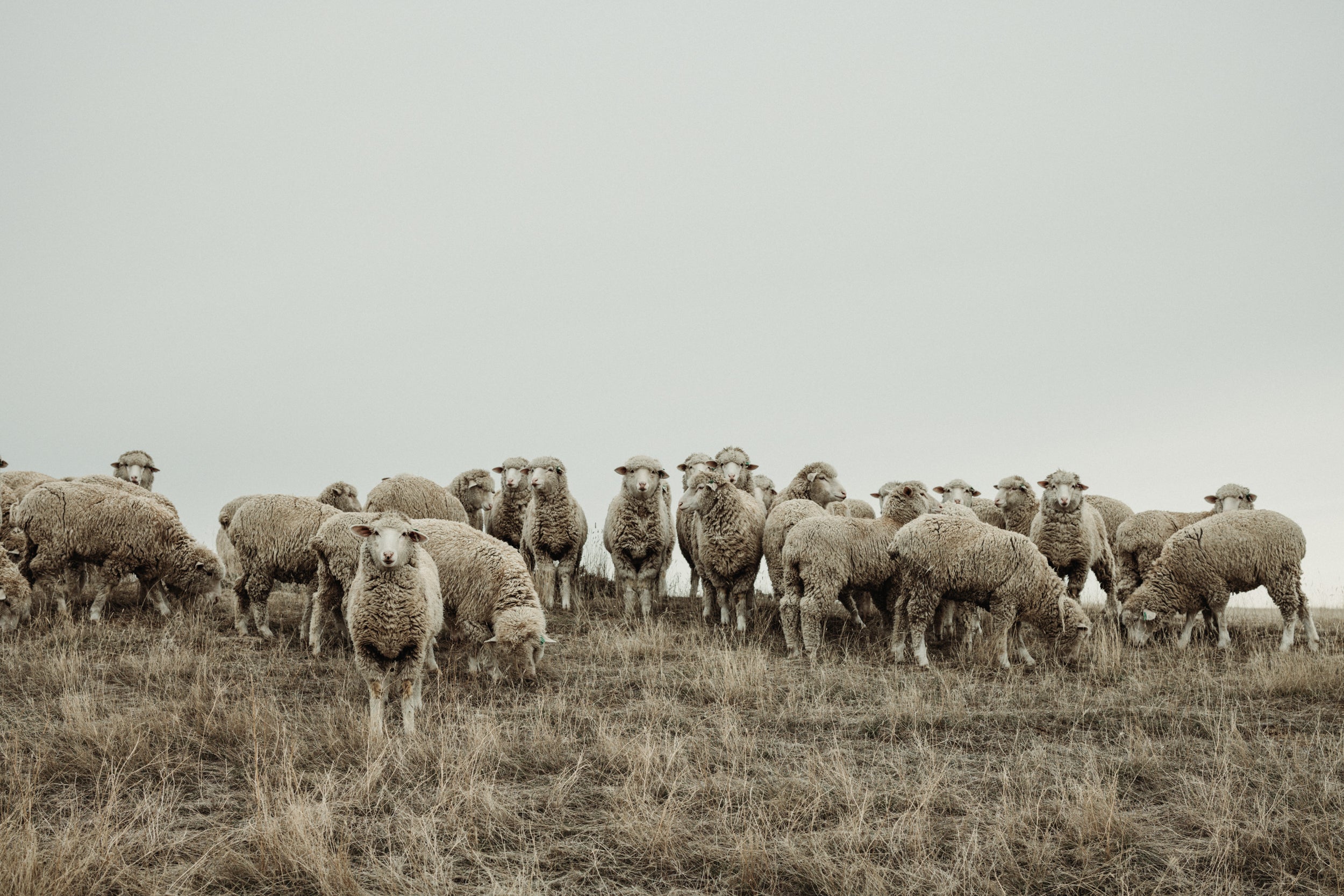New Jersey: THE SWAMP

This is just such a nice picture ... woods greening up in spring, the doe looks like she's made it thru winter in good shape and finally getting into some nice green feed, and now she's taking her leisure checking out a licking branch.
It was Very Strange the way it worked in the summer of 1997, but I was actually looking to buy a boat, not a piece of recreational property.
There is a great weekly magazine, THE FISHERMAN, published for New Jersey area anglers, and I'd been watching the want-ads for a small used boat. On my way to work one morning I found a $20 bill on the sidewalk near the train station. And I had a feeling that another piece of luck was heading my way. So I opened up THE FISHERMAN, thinking today was the day I'd find my boat. But what I found instead was an ad placed by a guy who was looking for a couple of partners to buy 27 acres (11 hectares) at the edge of the 4-square mile (1000+ hectares) Hatfield Swamp, 9 miles (14 kilometers) from my house.
So I checked it out. It wasn't real pretty. BUT it was close to home and close to New York City's Times Square, where I was working at the time. The property was wooded, with a 5-acre (2 hectare) lake, a couple of little shooting ranges, and mostly bounded by a river. It was a place to shoot, fish, hunt, canoe, observe abundant and diverse Nature or just get out for a while. So ... I was IN! (And years later it became a place to test and photograph WeatherWool!)
We've gotten huge use out of THE SWAMP. It's not the best place for anything, but it is a really good place for a lot of things! And it is certainly one of my very favorite places.

MYSTERY OF THE CLAM SHELLS!
Clam shells along the shore of the Rockaway River (above and below). They are small, about 1 inch (2.5 cm) across. There are huge numbers of clams in the river, and there are a lot of shells along the bank. For a while, I suspected otters put them there, although I have never found any evidence of breakage or tooth marks. But these shells didn't get out of the water by themselves ... And sometimes, the piles are pretty big. There had to have been over 1000 clamshells right around those in the photo below. I checked with the State of New Jersey and the biologists said they are Asian Clams and just about everything eats them ... fish, waterfowl, mink, otter, raccoon ... but the shells in this picture may be due to a high-temperature, low-oxygen die-off. The biologists weren't comfortable explaining the piles of shells well above the water, tho ... because any land-based predator would have damaged the shells to get at the clams. My best guess now is that they've been swallowed whole and passed by ducks. There does not seem to be even a bit of clam meat clinging to any of the shells, so that, plus undamaged shells, supports, I think, the idea that ducks ate them. One study from 1986 showed that in the Carolinas, the diet of Lesser Scaup, which winter in New Jersey, was 50% Asian clams. And if the Scaup eat them, probably other ducks do, too. However, when eiders eat mussels (there are mussels here as well), their gizzards grind them up. I haven't found any references to whether the Asian clam shells are passed intact by waterfowl. My own guess is that otter collect the shells and wait until the clams open on their own.

The Swamp is nestled just upstream from the confluence of the Rockaway and Passaic Rivers, and just downstream from the confluence of the Whippany River and the Rockaway. It’s part of a dedicated wetlands area that spans probably 5 square miles (1300 hectares). And although The Swamp is only about 20 miles (32 km) from Manhattan, little or none of this land can be developed because when we get any real rain, it floods. And I mean FLOODS. The floodwaters have destroyed two of Alex's trail cameras, and they were 4 feet (1.2 meters) off the ground. When heavy rains are forecast, we just have to get in there and pull the cameras. I remember once parking my truck in about 6 inches (15 cm) of water, and watching minnows swimming around the tires while I was sighting in my gun for deer season.
In 2012, the entire East Coast of the USA was hit hard by Hurricane Sandy. We had huge rain and wind, and The Swamp was flooded big-time. It was probably two weeks after the storm before I got in there, and found our access road blocked by a tree trunk about 20-inches (51 cm) in diameter. And remarkably, resting against the tree trunk, was a chunk of a boat's hull! It was a BAD STORM! The tree trunk is covered with poison ivy vines. Poison ivy, and mosquitoes, are the dominant life forms there. The Swamp can be nasty!
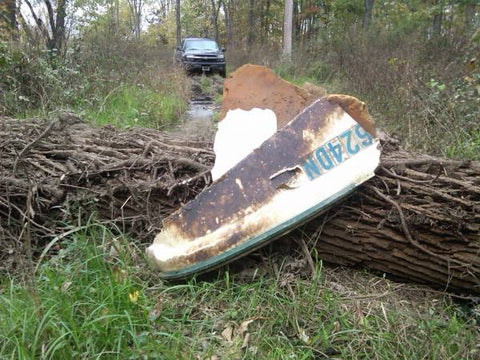
 This young Swamp Turkey was super, roasted slow with apples, onions and home-made maple syrup. (DiningWild ... appreciating wild foods is a big part of why we do WeatherWool ... but we are too busy with the wool to work on DiningWild and may never pick it up again.) He was fooled by a wingbone call made by a friend of my sister, and I was wearing WeatherWool, as usual. You can see also in this pic how well LYNX Pattern blends with fallen leaves. (A lot of experience has shown that animals just don't see me as human when wearing Drab Pants and Lynx Pattern Jacket.) What a great spring morning!!
This young Swamp Turkey was super, roasted slow with apples, onions and home-made maple syrup. (DiningWild ... appreciating wild foods is a big part of why we do WeatherWool ... but we are too busy with the wool to work on DiningWild and may never pick it up again.) He was fooled by a wingbone call made by a friend of my sister, and I was wearing WeatherWool, as usual. You can see also in this pic how well LYNX Pattern blends with fallen leaves. (A lot of experience has shown that animals just don't see me as human when wearing Drab Pants and Lynx Pattern Jacket.) What a great spring morning!!
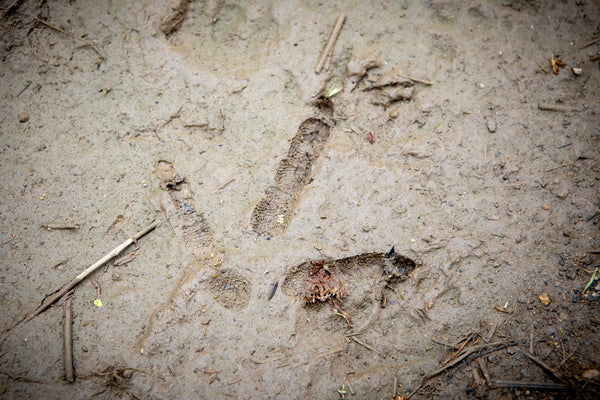
A track really does not get better than this. The scales on the bottom of the turkey's foot are visible.
The main shooting range offers a max shot of about 120 yards (109 meters). But the vegetation is so thick here that a deer at 100 yards (91 meters) usually can't even be seen.
The lake has lots of fish ... panfish, catfish, carp, largemouth, perch, pickerel. The river too. And remarkably enough, there are quite a few large Pike in the river. A friend-of-a-friend has caught some exceeding 36 inches (91 cm)! The large numbers of clams in the river was a surprise to me. Same with the mussels in the lake. We had the water tested years ago, to find out if we could swim there. The recommendation was NO SWIMMING. I was thinking industrial pollution would be the problem -- this is Jersey, after all. But no ... we were told swimming there would not be healthy because of the LARGE NUMBERS OF WATERFOWL! Huge numbers of ducks and geese spend time there, and an ace wingshooter would limit out every morning of duck season, without ever needing a decoy, a call or a blind, just pass-shooting.
There are also big numbers of turtles ... snappers and painters are the most conspicuous, but mud turtles, box turtles and, I think, sliders, too. On sunny and warm spring days, dozens of the painted turtles (and sliders?) come out of the water and bask on trees that have fallen into the lake. They prefer logs that can only be reached by water. The painters are, to me, anyway, shockingly wary. They will not let me walk anywhere near without diving into the water. Sometimes they will spot me 40 or 50 yards (40 meters) off in the woods. Why these turtles would be so spooky is something I would love to know. They must be subject to some predation ... they never bask in a spot that can be reached from land ... but what the predators might be I can only guess. Raccoon or mink or otter? Herons? The Swamp has all of them in abundance.
The woods are home to deer, squirrel, turkey, possum, coon, red and gray fox, coyote. Muskrats are around, of course, and mink and otter love the place. Beaver are becoming common. There are rare black bear, and in December of 2017 I saw a fisher!! It was only the second fisher I have ever seen. The other one was in Maine.
In early 2018, so many trees were knocked down by storms that our dirt two-track entrance road was blocked off all spring and summer. In October, I opened up most of it, but decided to keep the last 50 yards (45 meters) blocked off to vehicles because I could see deer were using our place a lot more than before. Also, much to my surprise, beaver had moved in. I hadn't seen any beaver sign on our land since about 2001.
Some years we also have rabbit and woodcock. There are plenty of birds of prey, plus a wide variety of water birds like egret and herons, and sometimes bitterns and kingfishers. In the 1990s we had quite a few rail, but I probably haven't seen a rail since 2000. Owls are common and it is really cool watching an owl turn its head 180 degrees or more to get a good look at me creeping up from behind.
 My friend Dan, a foraging enthusiast, had never hunted until he joined me at The Swamp. He needed only two hours to down his first deer, and three hours for his first turkey. I have never heard of anyone pulling off such a double!! This pic was taken in 2012, before we had finished development of our Fabric.
My friend Dan, a foraging enthusiast, had never hunted until he joined me at The Swamp. He needed only two hours to down his first deer, and three hours for his first turkey. I have never heard of anyone pulling off such a double!! This pic was taken in 2012, before we had finished development of our Fabric.
The Swamp's Deer Seasons are over 5 months long, with no limit on antlerless deer, and 6 bucks per year. Spring Gobbler Season can be awfully generous too. Generally there are more tags available than hunters ... which means the theoretical limit on gobblers is one daily and about 30 each spring. But I feel lucky to take one for the season. In 2015, for the first time, the Fish and Game folks opened Fall Turkey and Bear Seasons for this area. I put out a bear bait and a trailcam to see if anything came in. The trailcam was stolen within 48 hours. ... Jersey ...
 One more month (American-style date is 4 September 2010) and these three bucks may not be so easy with each other ...
One more month (American-style date is 4 September 2010) and these three bucks may not be so easy with each other ...
My kids all began to drive here in 1997 ... the dirt access road is almost a half mile (about 3/4 of a km). Alex began driving at 13, Zack at 11 and Denali at 9. For this reason alone the kids still love the place!!
 STARE DOWN: We usually have a trail cam or two working for us.
STARE DOWN: We usually have a trail cam or two working for us.
It looks like the young buck and young raccoon are not happy with each other.
This buck is not one of the three bucks in the previous picture, taken 19 hours earlier.
In the year 2000, my younger son Zack killed his first deer at The Swamp ... the culmination of a picture-perfect deer push. At about 8AM, I shot a very big doe, and Alex was hunting 200 yards (183 meters) away from me. Most of the time, if Alex hears me shoot he'll come to find out what happened. So I wasn't surprised when he showed up. After getting my deer taken care of, we decided to check on Zack, who was 14 at the time. Zack was about 150 yards (137 meters) beyond the lake, backed up against the Rockaway River. We figured it would be worth tiptoeing our way towards him, with each of us taking a different route around the lake. There is an area of thick brush and mounds where the deer like to bed because it is always dry and because, I think, they can more easily detect any approaching danger when bedded a little higher than the surrounding land. Evidently I spooked the deer, and they ran across in front of Zack. But they were too far and moving too fast for him to get a shot. After they crossed in front of Zack, tho, they must have realized Alex was coming around the other side of the lake. So they stopped and cut a diagonal, which brought them right in front of Zack. A fat young doe gave Z a standing broadside shot at about 15 yards and she dropped in her tracks.
In late January of 2015, I took a quick trip to The Swamp to see if we could find a goose for Camo. North Jersey's Rockaway River was high due to heavy rain over the weekend, and most of our little swamp spot was flooded. But that often brings in the waterfowl. The geese and particularly the ducks love to feed in the flooded timber, and on this day they chose our timber. We could hear the mallards quacking from a couple hundred yards away and as we got closer we spotted geese. We love fried mallard, but duck season had closed on the 10th, so today was goose only. Our dog, Camo, a Large Munsterlander, was 14 years old in 2015 and it's great to see her retrieve a goose, which is her favorite. The LM is a little-known breed in the USA ... versatile hunting dogs from Germany. They'll do anything you might want a dog to do around here. Point birds, retrieve from land or water, run rabbits and protect the garden from varmints. When we got within maybe 75 yards (69 meters) of the nearest mallards, they noticed us and took off. Within a few seconds ducks were flying everywhere, at least a couple hundred of them. A group of geese crossed in front, over the river about 30 yards (27 meters) off, and the nearest one, at the rear of the formation, dropped into the Rockaway at the shot. The temperature was a little above freezing, but there was still plenty of ice around so the water had to be cold. LMs have no subcutaneous fat and no oil in their fur, so you can't ask them to do real cold-weather work like a Lab or a Chessie. Camo did her thing tho, swimming out into the river and retrieving a Giant Canada Goose in fine style. Ten or even 5 years ago we might have stayed in the field, but age 14 is old for a dog and Camo was shivering a little, so we headed for the truck. Nice work Old Girl!
Below are a few pictures from September of 2015 ... Camo got her 15th Season off to a good start. Geese really turn her crank. Interesting thing happened. She was retrieving a bird and spotted another goose swimming. She went after it – she could outswim geese -- and swam fast enough that the goose was forced to fly … to my gun. So what she did was actually flush a goose out of the river … pretty much the way she'd flush a woodcock ... except she was swimming!
 The Giant Canadas weigh 12 pounds at maturity, with ganders sometimes exceeding 20 pounds (9 kg). Camo weighs about 50 pounds (23 kg), so even an average Giant is a load for her.
The Giant Canadas weigh 12 pounds at maturity, with ganders sometimes exceeding 20 pounds (9 kg). Camo weighs about 50 pounds (23 kg), so even an average Giant is a load for her.
She brought it to shore no problem, but bringing it all the way to me was a different story.
I'm wearing the first All-Around Jac we ever made. Debby doesn't like me to wear it because we changed the design and improved the tailoring quite a bit. But I like to keep wearing this old one because it's made from our true production Fabric and it has more use on it than any other WeatherWool I have ... so now I'm testing for durability. The temp was about 75F/24C. I was fine wearing the wool until I started hauling 60 or maybe 70 pounds (32 kgs) of geese. Thanks to Fisher Neal for doing most of the shooting, half the carrying and all of the cleaning! Fisher is a multi-faceted guy ... a true professional actor and hunting guide who also teaches people to hunt! And we are happy to have Fisher as a WeatherWool Advisor.
Camo was still rocking and rolling in November 2016, when the pic below was taken. There were a flock of geese on the pond, on the far shore, well out of shotgun range. Camo saw them, and went in after them. When she got close to the geese, they started swimming away, but with no current to fight, she swims faster than they do and they were forced to fly. She made a nice retrieve on one that flew within shotgun range. Given her age and the temperature being right at the freezing mark, I thought she might be too cold to continue hunting, but just the opposite!



My Cousin Al had never hunted waterfowl before, and this was our first hunt together. He had only one chance this morning and he made it count on a banded Giant Canada Goose. Not sure I have ever heard of anyone taking a banded bird with his first-ever waterfowl shot. A great omen!! This goose was banded four years earlier, in North Carolina. Al also made meat the first time he hunted deer at The Swamp! ... Also, Jersey is a serious football State. In 2011, Al, his brother, and another of our cousins all played football for Don Bosco High School's National Championship Team, which was coached by Greg Toal, one of my own buds from high school.
The Rockaway River defines most of the borders of our land, and that adds a lot to the scenic value and interest of the property. In Spring we frequently see spawning masses of carp. One September, we had a good rain and the River was up a foot or two the next day. Walking along the banks, I was shocked to see hundreds of large carp feeding on something on the newly-submerged area. It's unusual, outside spawning season, to see any carp ... they are fairly shy. But that one day they were everywhere ... large ones. When I told this story to a friend, he said CARPE DIEM. Great line. Anyway, all those carp help to explain the presence of the giant pike.
Thanks to Instagram, we have gotten to know a gentleman named David Alexander (@NatureIntoAction on Instagram), below, who works at the Essex County Environmental Center, which is a mile or so downstream from our place. It was there that our kids took their Hunter Ed courses, and Debby earned her Master Gardener Certification. In summer of 2019, David joined us as an Advisor. David's YouTube Channel has great content and a large following, and he also works as an Assistant Guide with Fisher Neal. On September 1, 2017, David wet a line on his lunch break, and caught this pike on his second cast:
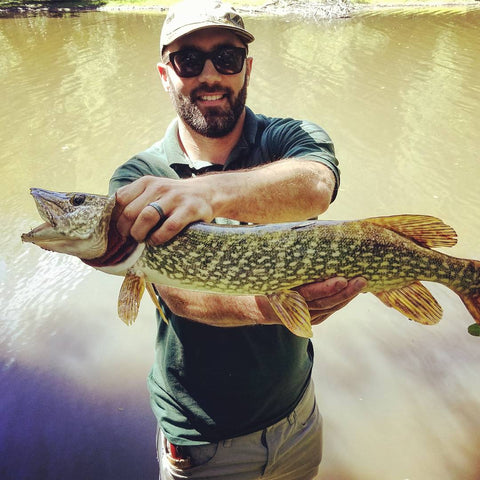
The Passaic River runs 80 miles (129 km) from some of Jersey's old-money suburbs to Paterson, Passaic, Newark and finally Newark Bay, which is part of New York Harbor. The upper reaches of the River are clean and beautiful, the lower reaches were despoiled by extreme industrial pollution. But huge cleanup efforts have had a remarkable effect, and the Passaic gets cleaner every day. In the 1930s, the Passaic was clean enough that it supported large numbers of Blue Claw Crabs, and people caught them for food.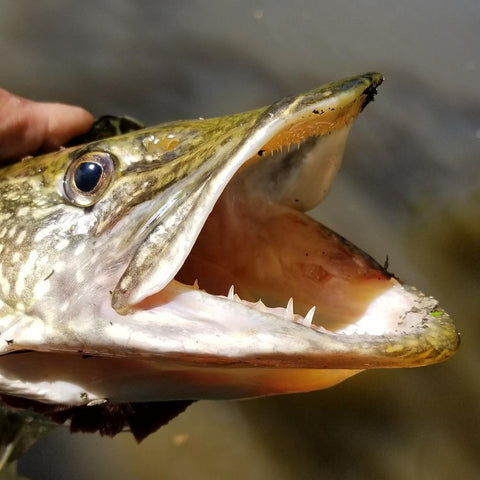
Funny story from 1998. My daughter Laura (my preference was to name her Denali, and that has become her "WeatherWool name"!) told me she wanted to take the Hunter Ed course. I was delighted with the idea of Denali joining me and her older brothers in the deer woods. There were about 20 fathers and sons at the class, which was held at the nearby (other side of the swamp) Environmental Center, and Denali, who was 10, was the only female. The instructor showed a picture of a skylined buck, and asked the class whether they would shoot. The correct answer is that you never shoot at an animal against the skyline, because you can't be sure your shot would be safe. Denali raised her hand, and when called on, she answered correctly, NO! When the instructor asked WHY this was not a shot to take, she responded loudly and passionately BECAUSE THE DEER SHOULD BE ALLOWED TO LIVE!! On the way home, Denali explained she wanted to take the course to learn why I hunt. Hopefully, every hunter can appreciate some of her feelings. I would still not be surprised if Denali someday starts to hunt. For a while, she was a vegetarian, but did not feel strong and healthy enough, so she started eating meat, but only wild game because she felt that meat was Natural.
The funniest story from The Swamp was Fisher being "outfoxed", literally and figuratively. Fisher was alone, hunting ducks, and he'd bagged a couple, which he secured together with a leather strap. Fisher continued his hunt, and was hiding along the riverbank, calling for more ducks. He noticed a fox, and was surprised the fox could be so close and still think he was hearing a duck and not smelling a human. Fisher was briefly pleased with himself for fooling a fox, but after a couple of minutes realized the fox had stolen his ducks!
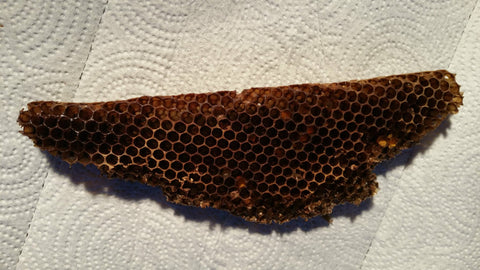
In the picture below, the River is fairly high, although I have been there (in a canoe) when it was 5 feet (1.5 meters) higher ... and at times it gets much higher still. Part of what makes the River so attractive is that it is constantly changing, and, of course, can change quite quickly.
People are often somewhat surprised to see how well LYNX blends with fallen leaves in autumn and winter. But often, fallen leaves are fairly light in color. Below, in January 2016, Debby wears the Ladies Field Jacket and Big Brim Boonie Hat in LYNX Pattern. The black dog (Camo) and black pants are conspicuous ... LYNX fades right in.
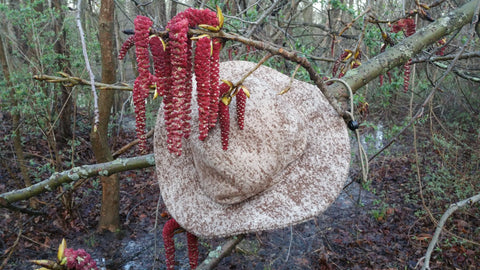
Catkins!! Anyone know what kind of catkins these are? Someone on Instagram was pretty sure they are Eastern Cottonwood, and I think that is correct. Here in New Jersey we had a nasty snowstorm in March, 2018 ... extremely heavy snow knocked down a lot of trees, but many of them were not uprooted, and survive at ground level, with more or less horizontal trunks. These strikingly beautiful catkins would normally have been way up high where I could not get a good look at them. But at sunup this morning in the 2018 Turkey Season, they were beautiful as could be. Sunup is always a wonder, and here at The Swamp ... pure magic.
Some days The Swamp gives up what we don't expect and were not looking for. In September of 2015 I was actually hoping to bring home a young goose to roast for dinner. I didn't get within range of any geese but Oyster Mushrooms were fruiting in profusion. I forgot to bring my usual mesh bag, but these ‘shrooms were too nice to leave behind. So my Ball Cap was pressed into duty as a mushroom sack. It was actually big enough to hold a pound or so (500 grams). If you are interested in Wild Foods, you may want to check out WildFed, a TV Show devoted to Wild Foods. WildFed is the creation of WeatherWool Advisor Daniel Vitalis. Dan is doing a super job with WildFed!! Oyster Mushrooms are easily recognized but still, DO NOT EVER GUESS when it comes to any Wild Food. Please: WHEN IN DOUBT, THROW IT OUT!
This is a use for which the Ball Cap was not designed!
It was the same story in October, 2015. Camo and I had mallards in mind but sometimes the ducks don't show at The Swamp until we get some cool weather. But we lucked into several blooms of Hen-of-the-Woods. In the picture below, the big one at left is a little old and will go for soup stock, but the others are in great shape for the local markets. Hen-of-the-Woods Mushrooms. These are typically huge fruiting bodies. Shotgun included for size reference and humor.
Hen-of-the-Woods Mushrooms. These are typically huge fruiting bodies. Shotgun included for size reference and humor.
Same sort of strikeout in December 2015... First, I was after deer ... no dice ... went back with the dog looking for waterfowl ... but they weren't around either. But we found some mushrooms, and real quantities in the oyster department!

Above, the beautiful Lion's Mane. This one is about 5 inches across and was so bright in the gloomy December woods that I spotted it from 100 yards (91 meters) away. Lion's Mane is another choice edible.

Often, when you find oysters, you find a lot of them. Debby makes fantastic oyster soup. And they are incredible sauteed.

Wood ears are cool little edibles. Denali brought this knife home from Tanzania for me.

The remains of a Coopers Hawk. I have no idea how it died, or if it was killed. I had passed this spot the day before, so I know the hawk had just recently met its end. The hawk may have been killed and eaten by a Great Horned Owl, which are known to prey on raptors at night.
The photo below shows a Little Blue Heron (I believe!) that is living its last days. Herons are normally extremely shy of people, but this one let me walk right up on it. I didn't know it was there until it stepped into the water. The immediate area was covered with its tracks. I'm guessing it can no longer fly, and if that's correct, it will soon meet the fate of the Coopers Hawk.

Prior to, and during the mating season, whitetail bucks rub trees with their antlers. Some say it is to work off energy, some say it is a signpost to other deer. I don't doubt it works off energy, but I'm completely convinced it is a signpost to other deer. And I'm also of the school that believes the bigger the tree, the bigger the buck's antlers. Big bucks may, and do, rub small trees, but small bucks do not rub big trees. This tree is probably the biggest I have seen a buck rub at The Swamp. You can clearly see the parallel marks from the buck's brow tines (the tines nearest the base of the antlers). Interestingly, many bucks at The Swamp do not grow brow tines until later in life, if at all. In most places, bucks grow brow tines as soon as they grow antlers with main beams. This tree is about 8-9 inches across where the buck rubbed it ... that means his antlers were wide enough to accommodate the tree. The cross-section of the tree was elliptical, and if he'd rubbed the wider part, it would have been more like 10-11 inches (26 cm). I'm wearing my old All-Around Jacket in Lynx Pattern, the first jacket we made, prior to switching to Slot Buttons.
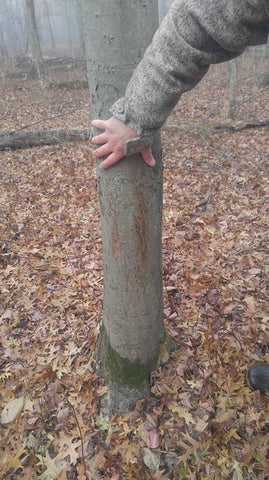
In Fall of 2016, Camo and I were walking along the riverbank looking for waterfowl when I spotted these two bucks sparring. Not a real fight, just a little shoving match. I got a few pictures before they noticed Camo and ran off.
About 10 days later, it was muzzleloader season, and my paperwork said any deer was legal. Several deer came by my stand early, and I took the first broadside chest shot that was presented. There was ample evidence of a lung hit-pass-thru shot, but very little blood trail as the deer ran off. I was following scuffed leaves more than anything else, and it was slow going. After about 90 minutes I called my boys to help. Neither had been in the field with me ... Alex was working and Zack was getting ready to return to Wyoming at the end of a long Thanksgiving visit home.
I asked the boys to bring Camo. I have never used her for game recovery but that is something her breed is known for. At the time, I thought it was legal in Jersey to use a leashed dog for this purpose, but have since found out it was not. [It is now legal but highly restricted ... and we have actually had a gentlemen with a dog recover two deer for Fisher and his clients.] Fortunately, fifteen minutes after I phoned, and before the boys arrived with Camo, I found the deer. It had traveled about 500 yards after a high double-lung shot, and there was very little external bleeding. I was surprised to find I’d shot the same young buck I'd seen sparring. His unusual antlers and blond coat left no doubt. I would have preferred a big doe, which was what I expected. The buck bedded down and seemed to have expired very peacefully. I did move his head a little, into what seemed to me a more normal position, before this pic was taken. Other than that, this is just how I found him:
 It was like old times having the boys with me in the Swamp again, and since they've been old enough to hunt I have always badgered them into dragging my deer for me. So of course they dragged this one too ... but he was a little guy, so this was more tradition than need.
It was like old times having the boys with me in the Swamp again, and since they've been old enough to hunt I have always badgered them into dragging my deer for me. So of course they dragged this one too ... but he was a little guy, so this was more tradition than need.
My family actually has a history in this Swamp from nearly 100 years ago. In the mid-1920s, my Dad's father bought some land along the Rockaway River, less than a mile (maybe only 1 km) upstream from our swamp spot. The land was extremely fertile and great for farming except for one huge problem ... it routinely flooded, and Dad's family was forced to continue their farming elsewhere. Some other family used to live on some of the land we use now, however. The only trace they left is this 20-foot stone and cement chimney: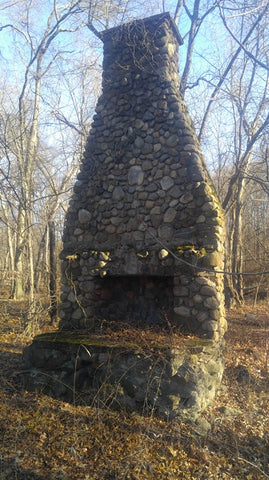
In the winter of 2016-2017, someone made a little camp on our land, along a bend in the Rockaway River. It's a nice spot, but I'm pretty sure whoever was spending time there was not in a frame of mind to appreciate that. A year later, when I took this photo, there was only a beach umbrella and a little trash left behind. But when we first discovered the camp, there was food, water, blankets, silverware. I left a note suggesting the person get in touch with police, or me, if s/he was in trouble. I'd like to think it was maybe just a litterbug teenager camping out for fun, or maybe temporarily angry with family.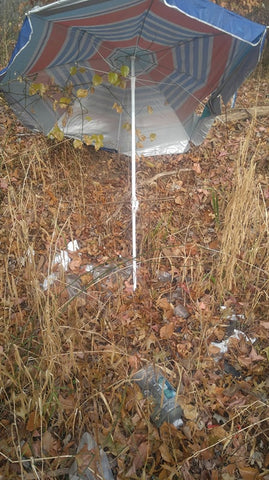

Deer absolutely hate walking on ice. But red fox and coyote like to walk on ice. The top photo is, I am pretty sure, red fox tracks. And the bottom photo is mostly the same, but with some raccoon and, I think, coyote tracks as well. The snow holding these tracks is only two days old. The Swamp is criss-crossed with drainage ditches dug by (guessing again!) the Army Corps of Engineers in the 1950s. The ditches usually hold some water, and when they ice over, they become a preferred travel route for fox and coyote.

The Swamp is also a great setting for photo shoots ... Lake, River, Forest ... 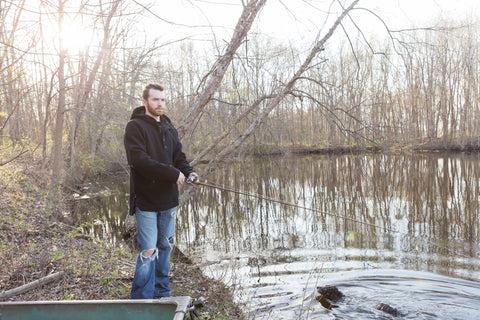 WeatherWool Advisor Fisher Neal is a hunting guide and instructor, Broadway actor, Ralph's hunting bud and sometimes a WeatherWool model ... here he is wearing our Anorak in Sold Black Color. Camo rarely missed a chance to swim.
WeatherWool Advisor Fisher Neal is a hunting guide and instructor, Broadway actor, Ralph's hunting bud and sometimes a WeatherWool model ... here he is wearing our Anorak in Sold Black Color. Camo rarely missed a chance to swim.
 Denali is a professional photographer, and all of the quality outdoor photography on this site was Denali's, until we started working with Trustin Timber in 2022. And now (Fall of 2017) that we are definitely going to production (eventually) with the Ladies Field Jacket, Denali is also our model. When she is both model and photographer, Denali sets up the camera exactly as it needs to be, and tells me "Push that button every three seconds." I don't push the button very well, but well enough! Super work, Denali!!
Denali is a professional photographer, and all of the quality outdoor photography on this site was Denali's, until we started working with Trustin Timber in 2022. And now (Fall of 2017) that we are definitely going to production (eventually) with the Ladies Field Jacket, Denali is also our model. When she is both model and photographer, Denali sets up the camera exactly as it needs to be, and tells me "Push that button every three seconds." I don't push the button very well, but well enough! Super work, Denali!!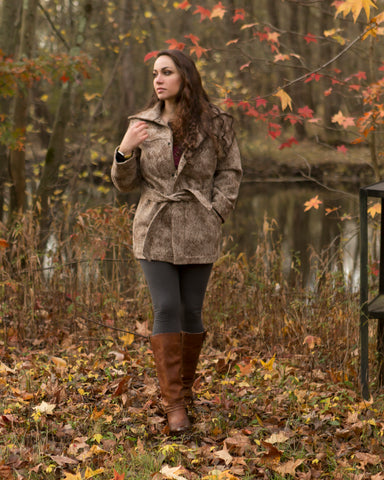
In December of 2017, we decided to do a video showing that you can get soaking wet on a cold day ... and if you are wearing the right clothing, it doesn't matter: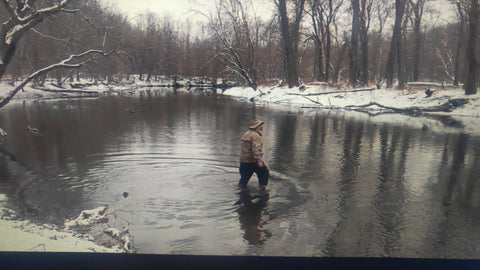
We shot a pretty good video of this icy swim and it's available on our Video-Performance page. It's also available on our WOOL AND WATER PAGE on this website.
There are a LOT of foxes in the area, and about a half-hour after this dunking I noticed some geese coming down to land on what I thought would have to be an ice-covered pond. This seemed odd, so I went over to investigate ... sure enough, about a dozen geese were standing near the middle of the pond, on solid ice. As I watched, a fox jogged out of the trees, and closed to within a few yards (a few meters) of the geese. The geese showed no fear, it seemed to me ... and I guess the fox agreed because he just loped away after a few seconds. Maybe he or she was looking to see if any of the geese were weak or injured? My friend Tom sent me a photo, taken maybe 20 miles (30 km) from The Swamp, of a fox standing in the midst of a group of turkeys. The foxes at The Swamp can be pretty entertaining!
In 2018, we had overall pretty much the wettest year ever in the Northeast. And in March, we had a very, very heavy, wet snowfall that pulled down a lot of trees. The road into The Swamp was blocked by a bunch of blowdowns, but the heat came early, bringing skeeters with it, and I didn't get in there to cut back the blowdowns until October. My friend Tom (who sent the turkey/fox photo) had cleared much of the road, and I went in there to clear the rest.
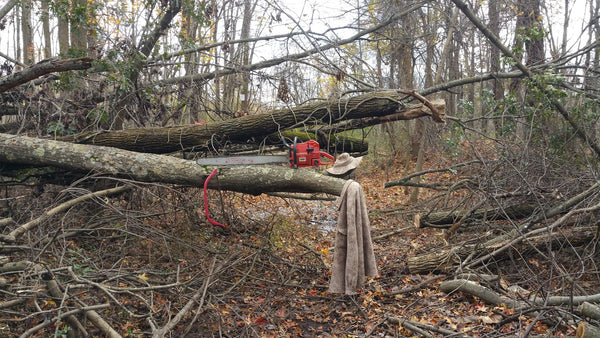
Tom had cleared 80% of the road ... when I went in to clear the rest, the only saw that was really running had a 36" (91 cm) bar. Not ideal for this small stuff!
But before I got to work clearing the last of the blowdowns, I took a little walk around and was really surprised, immediately, by how much deer sign there was. The deer had responded very positively to the privacy. But that wasn't all. Beavers moved in! I hadn't seen any beaver sign there in at least 15 years, but there is plenty of beaver activity as of Fall 2018. And so I decided to cut a walkway through the blowdowns, but for now, at least, we are keeping vehicles out.
I didn't actually see a beaver for years, but there is plenty of unmistakable beaver sign!
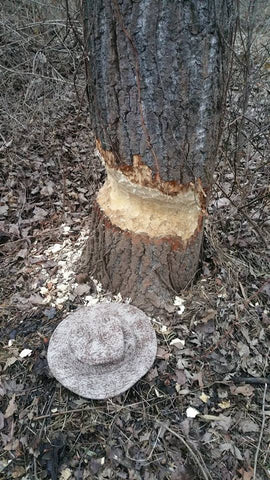 This tree is about 16 or 17 inches (42 cm) thick. About three years after this photo was taken, the tree broke off in a windstorm at the spot the beavers had chewed. The beavers built this lodge on the bank of the Rockaway River.
This tree is about 16 or 17 inches (42 cm) thick. About three years after this photo was taken, the tree broke off in a windstorm at the spot the beavers had chewed. The beavers built this lodge on the bank of the Rockaway River. 
In mid-March of 2023, Advisor Trustin Timber walked close to this lodge and believed a beaver was within, based on what he heard. A few weeks later, I saw a beaver swimming very near this lodge. That's the first time I've actually seen a beaver at our place.
One beautiful Spring morning, as I walked along the river, I saw something surface quickly and disappear, so I watched for a while, and a few minutes later it seemed two fish breached the water but I didn't get a clear look. Staying where I was a few minutes longer, I caught some motion to my right and saw a soaking-wet mink, hunting its way along the riverbank toward me. I believe what I'd seen earlier was a mink chasing fish, and the fish trying -- successfully, it seemed -- to escape. I was standing in the open, and didn't move except to grab my phone and prepare to take a photo. The mink walked up within 4 steps and looked right at me. But as usual, with Lynx Pattern on my head and torso and dark pants, the mink did not see me as a human and after staring a few seconds, continued on its way without alarm.

Mama Mia, The Swamp is JERSEY ... it's near one of America's most notorious Superfund cleanup sites. For decades the mafia ran a dump where they'd let you get rid of literally anything. Sharkey's Dump was shut down around 1972, and in the early 2000s, there was a huge effort to contain the toxic waste. I don't know what effect, if any, the work had. All the years of flooding and weather may have helped clean things up in a natural way. In any case, as long as I've been around the place it's been green as Ireland and loaded with wildlife. When we had the water in our lake tested, the chemist told us no way Sharkey's could affect us ... he said a couple of feet of dirt (less than 1 meter) is enough to filter out anything. Surprised me, but that's what he said. He also said that we should not swim in our lake, and I was expecting him to say there was some chemical contamination or similar. But the chemist said because there are so many waterfowl, it wouldn't be healthy for a human. Ducks and geese are not what I had been concerned about, but point well taken! This was why I kept my head out of the water when I did the aforementioned winter-river wool-test.
For a while, there was a motel about a mile (maybe 1.5 km) away, where the government used to house what seemed like waaaay too many people for the size of the place. And some trouble spilled over ... drug dealers found their way to our spot and evidently felt comfortable doing their thing around our lake. A body was found in plastic bags dumped beside the entrance to our dirt access road. But the police got that situation all cleaned up by maybe 2008. On the other hand, there is still plenty of JERSEY to go around, as shown in these next two pictures.
 Yeah, that's a picture of a tree growing up through an old tire ...
Yeah, that's a picture of a tree growing up through an old tire ... And this deer somehow got its front hoof stuck in the neck of what seems to be an old milk bottle. The glass is very heavy and thick. I don't know if the bottle would have broken off, but the edges were sharp and had cut down to the bone. The deer was limping, but otherwise, the deer was apparently perfectly healthy and normal.
And this deer somehow got its front hoof stuck in the neck of what seems to be an old milk bottle. The glass is very heavy and thick. I don't know if the bottle would have broken off, but the edges were sharp and had cut down to the bone. The deer was limping, but otherwise, the deer was apparently perfectly healthy and normal.

In 2024, someone installed a couple of sensor wells, one of which is smack-dab in the middle of our access road ... exactly where we turn up to get to our place, and where we frequently turn around or park. It's amazing to me someone would do this! As if it had to be EXACTLY THERE! I will try to find out who it is ... but it's an iron post, anchored in concrete, with some instruments inside. Fat chance they will move it. That's another Jersey-thing. Government feels very comfortable doing whatever it wants.
It's great to go to The Swamp and just experience what Nature has to show us ... the passing of the seasons ... the dry years, the flood years, the deafening flocks of many thousands of grackles, the turtles, the big, seldom-seen and lightning-fast black racer snakes. And even the changes over the years. My own perspective is that egrets were absent from New Jersey when I was a kid ... or at least I never saw one. But they are around now. We had the place for over 20 years before I ever saw a chipmunk there, near as I can remember. As of 2020, chipmunks are everywhere. But in Spring of 2022, I didn't see a single chippie.

 And as of Fall 2016, a Bald Eagle was with us!
And as of Fall 2016, a Bald Eagle was with us!
Thanks to Nick Laracca for being quick enough to get a cell phone pic!!
Spring 2017 warmed up somewhat early ... which meant the mosquitoes got going early, and when the skeeters are partying in The Swamp, it can get so bad that even with protective clothing, it seems wise to just stay out of there. So my 2017 Turkey Season was limited to a couple of hours on opening morning. And remarkably, I never heard or saw a turkey. But as I tiptoed along, calling every several minutes, I spotted a blond-phase red fox sleeping/resting on a log about 50 yards (45 meters) away. I’ve walked up on bedded critters many times before, but rarely have I spotted them in their beds before they erupted ... and I never spotted a bedded fox before it spotted me. But this time, with the fox a few feet above the ground, I was able to get a picture ... a pretty poor picture, I admit ... but this was a bedded fox!
A sleeping red fox!
In 2021, as if there wasn't enough viral disease around already, the deer were stricken extremely hard by EHD, Epizootic Hermorrhagic Disease. The deer in this photo, taken 24 September, should have been plump as could be. Instead, they clearly have no fat and have also clearly lost a lot of muscle. It seems almost all the deer infected by the disease will die, and it looks like that is almost all the deer in the area. I've gotten some horrible reports.

Thanks to Advisor Fisher Neal for this sad photo. These sick deer will almost certainly succumb to the virus very soon. In warm weather, Fisher visits The Swamp a lot more than me because he has a much higher tolerance for mosquitoes.
The deer herd will recover, but it may take a few years.
Back to good stuff!
In March of 2023, when Advisor Trustin Timber was in town, we met Advisor David Alexander at The Swamp, our little spot in the Jersey swamps not far from New York City.
 David and Trustin were well aware of each other through Instagram, but had never met until this month at The Swamp.
David and Trustin were well aware of each other through Instagram, but had never met until this month at The Swamp.
We met to get some imagery of David installing Wood Duck Nesting Boxes, but first, David surprised me with a very thoughtful gift ... some Taylor Ham made from venison harvested at The Swamp. Taylor Ham is a breakfast sausage and something of a New Jersey totem. It was fantastic! THANKS, DAVID!!

David is Senior Naturalist for Essex County, New Jersey, which is on the other side of the Rockaway River, which forms most of the border of The Swamp. David is a Naturalist all the time, whether working or not, and installing Wood Duck Nesting Boxes is a typical activity. The Swamp is used by a lot of "woodies", and so it's a great place for the boxes. Woodies, as the name suggests, love timber and water. Watching them maneuver through the forest at high speed is always a pleasure. The visual acuity and maneuverability are extreme, at least from my perspective. They seem as nimble as much smaller birds. David explained the nesting boxes will be a place for the hens to lay and incubate eggs, but will be abandoned very quickly after the ducklings are hatched. Woodies will normally nest in cavities in trees, but there aren't enough of those to go around, and hopefully, the nesting boxes will protect the nesting hen and her eggs somewhat better than natural spots, which are more accessible to predators.

Wood ducks were, not so long ago, endangered because the spectacular plumage of the males was prized for decorative uses. Now, they are the most common ducks at The Swamp ... a remarkable "back from the brink" conservation success story!
Another nice thing about The Swamp is that it's been the location for many "firsts" for our family, friends, friends-of-friends ... Here are some of the things people have done for the first time here: canoeing, fishing, foraging (plants, fish, animals, mushrooms), birding (many new birds), shooting (bow, crossbow, rifle, pistol, shotgun, muzzleloader, slingshot, blowgun, atlatl, paintball), driving (car, truck, ATV, motorcycle), camping (kids first overnight without parents), mammals seen for first time, tracking, first hunts for a bunch of people, first time seeing many types of animal behaviors, first time hearing peepers in Spring (they can be amazing), first hunts, first game taken (deer, ducks, geese, squirrel, turkey) ...
We are ridiculously lucky to have THE SWAMP!

27 December 2024 --- Ralph



